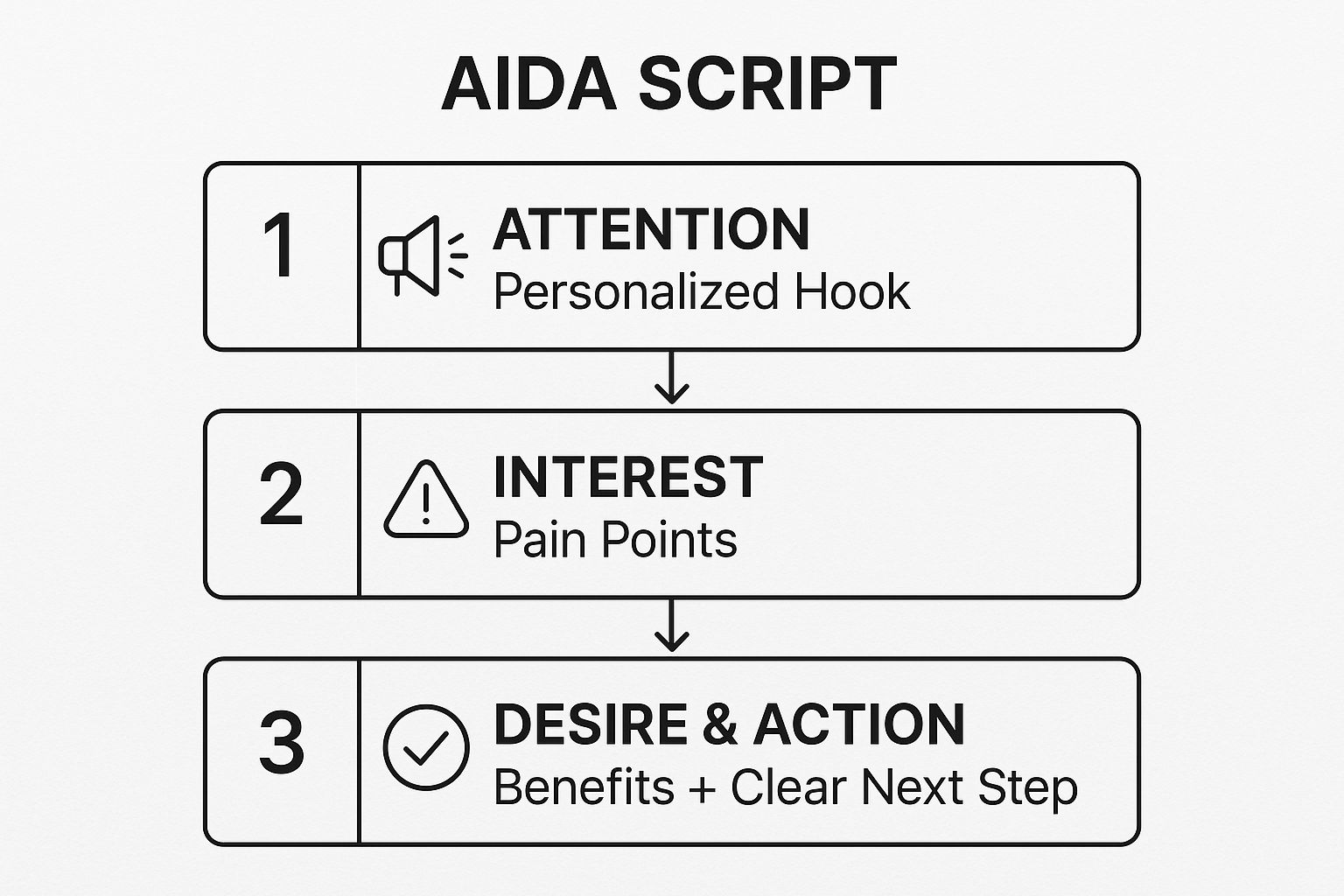Cold calling is far from dead, but your script might be. If you're tired of hearing "not interested" before you even finish your introduction, the problem isn't the channel itself, it's the execution. A generic, robotic script fails because it focuses on your product instead of the prospect's problems. It sounds like a sales pitch from the first second, triggering immediate resistance and making it impossible to build any real connection.
The truth is, a powerful cold call is a strategic conversation, not a monologue. Success hinges on a well-structured script that feels natural, delivers immediate value, and earns you the right to continue the discussion. It’s about being prepared, not sounding rehearsed. Many reps struggle not because they lack skill, but because they lack a framework that can adapt to a live conversation, especially when it comes to handling sales objections effectively. Without a solid plan for navigating pushback, even the best opener can fall flat.
This guide provides the solution. We're breaking down six proven cold calling scripts examples that transform your outreach from an unwelcome interruption into a valuable conversation. You won't find generic templates here. Instead, we'll dissect the strategy behind each script, offering detailed analysis and actionable takeaways you can implement today. From classic frameworks like AIDA to modern, insight-led approaches, you’ll learn how to build a script that opens doors, books meetings, and consistently generates pipeline.
1. The AIDA Cold Calling Script
The AIDA model is a classic marketing framework that provides a reliable structure for persuasive communication. Standing for Attention, Interest, Desire, and Action, it guides a prospect through a logical emotional journey, making it one of the most effective cold calling scripts examples for new and veteran reps alike.
The script’s strength lies in its sequential, step-by-step approach. You don't jump to the pitch; you methodically build a case, which feels more like a natural conversation and less like an aggressive sale.
How the AIDA Script Works
The AIDA framework breaks your call into four distinct phases.
- Attention: The first 5-10 seconds. Your goal is to interrupt their pattern with a compelling, personalized hook. This isn't the time for a generic "How are you today?"
- Interest: Once you have their attention, you must hold it. Connect your hook to a specific problem or goal relevant to their role or industry. Use data or insights to show you've done your homework.
- Desire: This is where you transition from their problem to your solution. You create desire by illustrating a better future-state and showing how your product or service delivers that outcome. Focus on benefits, not just features.
- Action: The final step is to propose a clear, low-friction next step. This could be a 15-minute demo, a follow-up email with a case study, or a discovery call.
The following infographic illustrates the core flow of an AIDA cold call.

This process shows how the script moves from a broad, personalized hook to a specific, benefit-driven call to action.
When and Why to Use This Script
The AIDA script is highly versatile, but it excels in situations where you need to educate the prospect before you can sell. If your product or service solves a complex problem or is in a new category, this structured approach helps build understanding and buy-in. It's also perfect for training new sales reps because its clear phases are easy to learn, practice, and master.
Key Tactic: Spend the majority of your prep time on the "Attention" and "Interest" stages. Researching a specific company trigger or a powerful industry statistic will make the first 20 seconds of your call exponentially more effective.
Actionable Tips for Implementation
To make this script work, focus on the details of each stage.
- Personalize the Hook: For the Attention phase, reference a recent company announcement, a LinkedIn post by the prospect, or a shared connection. Example: "Hi John, I saw your company just expanded its logistics operations into the Southwest…"
- Use Data to Build Interest: Instead of vague claims, use specific numbers. Example: "…and I was curious how you're handling the 25% increase in fuel costs affecting fleets in that region."
- Connect Benefits to Pain: In the Desire phase, tie your solution directly to the problem you identified. Example: "Clients using our route optimization software are cutting fuel costs by an average of 15% in the first three months."
The AIDA model provides a powerful foundation for structuring persuasive outreach, and its principles can be adapted for written communication as well. You can find similar frameworks in these cold outreach email templates.
2. The Permission-Based Cold Calling Script
The Permission-Based approach flips the traditional cold call dynamic on its head. Instead of launching into a pitch, you immediately ask for permission to speak, putting the prospect in control. This respectful opening, often associated with methodologies like Ari Galper's "Unlock the Game," disarms the prospect, lowers their natural resistance, and filters for genuine interest right from the start.
This script’s power comes from its psychological impact. By asking for permission, you show respect for the prospect's time and position them as the decision-maker. This creates a more collaborative and less confrontational tone for the conversation, making it one of the most effective cold calling scripts examples for building trust quickly.

How the Permission-Based Script Works
This script focuses on a simple, three-part flow designed to earn a conversation rather than demand one.
- Introduction and Context: State your name and company clearly, then provide immediate context for why you are calling them specifically. This should be a concise, one-sentence value statement.
- The Ask (Permission): Directly ask for a small amount of their time. The classic phrase is, "Do you have 30 seconds for me to tell you why I'm calling?" This is a low-commitment, easy-to-accept request.
- Pivot or Graceful Exit: If they say yes, you pivot directly to your core value proposition or a relevant question. If they say no, you thank them for their time and exit gracefully, preserving the relationship for future outreach.
This process ensures that you only spend time pitching to prospects who have explicitly agreed to listen, dramatically improving the quality of your conversations.
When and Why to Use This Script
The Permission-Based script is ideal for industries where building trust and long-term relationships is paramount, such as high-value B2B consulting, financial services, or enterprise software. It works exceptionally well when calling senior-level executives who are short on time and appreciate direct, respectful communication.
Use this script to differentiate yourself from aggressive competitors. When everyone else is pushing a hard sell, this pattern-interrupting approach feels refreshingly honest and can make a memorable first impression.
Key Tactic: The tone of your voice when asking for permission is critical. It should be calm, confident, and professional, not needy or apologetic. You are a peer seeking a brief moment of their time, not a subordinate asking for a favor.
Actionable Tips for Implementation
To maximize the effectiveness of this script, focus on the delivery and your follow-through.
- Craft a Compelling Context Statement: The reason you're calling must be concise and intriguing. Example: "Hi Sarah, my name is Alex from FinOptics. I'm calling because I noticed your CFO mentioned a focus on reducing operational overhead for Q3…"
- Time Your Ask Perfectly: Deliver your context statement and immediately follow it with the permission question. Example: "…is now a bad time for a 30-second explanation?" The pause after this question is crucial.
- Prepare Your Pivot: When they grant permission, be ready with a powerful, benefit-driven statement or question. Example: "Great. We help logistics firms like yours identify an average of 15% in hidden supply chain costs. I was curious how you are currently tackling rising transportation expenses."
- Respect the "No": If they decline, respond professionally. "No problem at all, I appreciate your honesty. Is it okay if I send a brief follow-up email with some information for you to review later?" This respects their decision while creating an opportunity for future contact.
3. The Problem-Agitation-Solution (PAS) Script
The Problem-Agitation-Solution (PAS) model is a powerful psychological framework borrowed from direct response copywriting. It's built on the principle that people are often more motivated to act to avoid pain than to gain pleasure. This script focuses on identifying a known pain point, making the prospect feel the full weight of that pain, and then presenting your offering as the perfect relief.
The strength of this model lies in its emotional impact. Instead of leading with benefits, it connects with the prospect's real-world frustrations, making your solution feel less like a nice-to-have and more like a must-have.

How the PAS Script Works
The PAS framework guides the conversation through three distinct emotional stages.
- Problem: Start by stating a specific, high-stakes problem that is highly relevant to the prospect’s role or industry. This requires pre-call research to ensure your opening resonates immediately.
- Agitate: This is the crucial step. Don't just state the problem; expand on it. Use questions and data to highlight the negative consequences: lost time, wasted budget, compliance risks, or competitive disadvantages. You’re pouring salt in the wound to create urgency.
- Solution: Once the pain is keenly felt, you introduce your product or service as the clear, direct solution. The transition should be a pivot from "Here’s how bad it is" to "But it doesn't have to be that way."
This flow creates a narrative where the prospect is the protagonist facing a challenge, and you are the guide with the tool they need to succeed.
When and Why to Use This Script
The PAS script is incredibly effective when you are selling a "painkiller" product rather than a "vitamin." If your solution directly solves a costly, time-consuming, or high-risk issue, this is the framework for you. It's ideal for mature markets where prospects are aware of their problems but may be complacent or unaware of the true costs of inaction.
Cybersecurity firms agitating the financial and reputational cost of a data breach, or HR software providers highlighting the penalties of non-compliance, are classic examples where PAS excels. It forces the prospect to confront the consequences of doing nothing.
Key Tactic: The "Agitate" phase is where the magic happens. Use open-ended questions like, "What happens when that process fails?" or "How much time is your team losing to that manual task each week?" to get the prospect to articulate the pain in their own words.
Actionable Tips for Implementation
To execute this script effectively, your delivery must be empathetic, not aggressive.
- State a Specific Problem: Instead of a generic opening, be precise. Example: "Hi Sarah, I'm calling because I saw you’re hiring three new sales managers. Many leaders I speak with in your position are concerned about the long ramp-up time for new hires."
- Agitate with 'What If' Scenarios: Gently poke at the consequences. Example: "With a 6-month ramp time, what's the downstream impact on hitting quarterly revenue targets if even one of those hires doesn't work out?"
- Present a Focused Solution: Make a direct connection between the agitated pain and your fix. Example: "Our sales onboarding platform helps teams cut ramp time by 40%, ensuring new managers are contributing to revenue in their first quarter."
Mastering the PAS framework can transform your outreach, making it one of the most compelling cold calling scripts examples for creating immediate urgency and motivating action.
4. The Referral Cold Calling Script
The Referral Script transforms a cold call into a warm introduction by leveraging a mutual connection. This approach instantly builds trust and credibility, dramatically lowering the prospect's natural defensiveness. By opening with the name of someone the prospect knows and respects, you immediately differentiate yourself from a typical, unsolicited sales call.
This script’s power comes from social proof. The implied endorsement from a shared contact creates a powerful psychological shortcut, making the prospect more receptive to hearing what you have to say. It reframes the conversation from "Why are you calling me?" to "Why did our mutual connection think we should talk?"
How the Referral Script Works
This script focuses on establishing a bridge of trust before presenting any business value.
- The Opener: The first 5-10 seconds are dedicated to clearly and confidently stating the mutual connection's name. Example: “Hi Jane, my name is Alex, and John Smith suggested I give you a call.”
- The Context: Immediately follow up by explaining the context of the referral. Why did John suggest you call? This clarifies the purpose and reinforces the legitimacy of your outreach.
- The Pivot: Once the connection is established, you must smoothly transition to the prospect’s world. Connect the reason for the referral to a specific challenge or goal relevant to them.
- The Ask: Conclude with a low-commitment call to action that honors the referral, such as a brief discovery call to see if the connection is valuable.
This approach bypasses the typical barriers of cold outreach by using a trusted name as the key to opening the door.
When and Why to Use This Script
The Referral Script is one of the most effective cold calling scripts examples for any industry but is particularly potent in relationship-driven sectors like professional services, high-ticket SaaS, and consulting. It is the go-to script when you have a strong network and can leverage existing client or partner relationships to generate new leads.
Use this script when you need to access senior-level decision-makers who are heavily gate-kept. A referral from a trusted peer or colleague is often the only way to get their attention. It’s a fundamental tool for any organization that wants to build a systematic referral engine.
Key Tactic: Always get explicit permission from your referrer before using their name. Ask them, "Would you be comfortable with me mentioning to [Prospect's Name] that you suggested we connect?" This protects your relationship and ensures the referral is solid.
Actionable Tips for Implementation
To execute this script flawlessly, preparation and communication are critical.
- Be Specific About the Connection: Don't just name-drop. Explain why the connection was made. Example: "Hi Sarah, John Doe and I were discussing logistics management, and he mentioned you were looking for ways to improve warehouse efficiency, which is why he suggested I reach out."
- Don't Overstate the Relationship: Be honest about your connection to the referrer. If you just met them at a conference, say that. Authenticity is crucial for maintaining trust.
- Transition to Value Quickly: While the referral opens the door, you still need to prove your value. Pivot quickly from the introduction to a relevant problem you can solve. Example: "Based on John's recommendation, I wanted to briefly share how we've helped similar operations managers cut picking errors by 30%."
Integrating this script into a broader strategy is key to maximizing its impact. You can learn more about how this fits into a larger sales process by exploring these sales enablement best practices.
5. The Insight-Led Cold Calling Script
The Insight-Led script flips the traditional sales model on its head. Instead of opening with your product, you lead with a valuable piece of information, a surprising industry trend, or a provocative insight that is immediately relevant to the prospect's world. This approach positions the caller as a knowledgeable advisor, earning credibility and curiosity from the very first sentence.
Popularized by methodologies like The Challenger Sale, its power lies in teaching the prospect something new about their own business. It shifts the dynamic from a sales pitch to a consultative conversation, making it one of the most effective cold calling scripts examples for building authority and trust.

How the Insight-Led Script Works
This script focuses on delivering value upfront, structured around three core phases.
- The Insight: Open with a compelling, data-backed insight specific to the prospect's industry or role. For example, a finding from your company's latest research report or a recent regulatory change.
- The Implication: Connect that insight directly to a potential problem or opportunity for the prospect's company. This is where you reframe their perspective and show them a challenge they might not have considered.
- The Solution: Introduce your product or service as the logical solution to the challenge or the best way to capitalize on the opportunity you've just revealed.
This flow is designed to disrupt the prospect's status quo by teaching them something valuable and then guiding them toward a solution.
When and Why to Use This Script
The Insight-Led script is ideal for complex sales cycles where you need to establish yourself as a thought leader. It works exceptionally well when targeting senior-level executives who are more interested in strategic business outcomes than product features. If you are selling into a competitive or saturated market, leading with a unique insight can immediately differentiate you from the noise.
This approach is a cornerstone of many modern B2B lead generation strategies, as it focuses on creating value before attempting to extract it. By offering expertise freely, you build the foundation for a more meaningful and productive business relationship.
Key Tactic: Your insight must be genuinely new or challenging to the prospect. If you're just telling them something they already know, the script falls flat. Your goal is the "aha" moment that makes them reconsider their current approach.
Actionable Tips for Implementation
To execute this script effectively, preparation is paramount.
- Invest in Research: For the Insight phase, regularly monitor industry publications, analyst reports, and market trends. Your company's proprietary data is a goldmine for creating unique insights.
- Tailor the Implication: Connect the insight to a specific business metric. Example: "Hi Sarah, our research shows that 60% of logistics firms are underutilizing warehouse capacity due to outdated inventory models. For a company your size, that could translate to over $200k in unnecessary carrying costs."
- Prepare Deepening Questions: In the Solution phase, be ready to pivot to discovery. Ask open-ended questions like, "How has this trend impacted your team's planning for the next quarter?" to guide the conversation.
By leading with value, the Insight-Led script transforms a cold interruption into a welcome consultation. This method is explored further in various B2B lead generation strategies.
6. The Straight-Line Cold Calling Script
The Straight-Line method is a direct, no-nonsense sales system popularized by Jordan Belfort. This framework is designed to move a prospect from the start of a conversation to a close in the most efficient way possible, a "straight line," while handling any objections or detours that arise.
Its strength lies in its relentless focus on establishing three key elements in the first few seconds: that you're sharp as a tack, enthusiastic as hell, and an expert in your field. The goal is to take control of the conversation immediately, guiding it toward a desired outcome while building subconscious rapport.
How the Straight-Line Script Works
This method operates on a linear progression, with the salesperson guiding the conversation and preventing it from straying off-topic.
- The Opening (First 4 Seconds): Your primary goal is to establish authority and tonality. You must sound upbeat, sharp, and like an expert who is worth listening to. This is about commanding attention through your delivery, not just your words.
- Intelligence Gathering: After your hook, you transition into a series of logical, well-structured questions. This isn't a passive discovery phase; it's a strategic process to uncover pain points that your solution directly addresses.
- The Pitch and Handling Objections: You present your solution in a way that directly resolves the pain you've uncovered. The core of the Straight-Line system is its process for looping. When a prospect objects, you don't fight it; you acknowledge it, pivot back to the line, and build more value before asking for the close again.
This script is less about a specific set of words and more about a system for controlling the conversational flow and building a logical case for action.
When and Why to Use This Script
The Straight-Line script is highly effective in high-volume, transactional B2B sales environments where speed and efficiency are critical. It's also a powerful tool for teams selling products or services with a clear, demonstrable value proposition, such as financial products or certain SaaS technologies.
However, its direct and assertive nature means it requires significant training and a certain personality to execute ethically and effectively. It’s not suitable for relationship-focused or highly consultative sales cycles where a softer approach is needed.
Key Tactic: Tonality is everything. The Straight-Line method posits that over 90% of communication is non-verbal. Practice your tone to convey authority, certainty, and enthusiasm. Your goal is to transfer a feeling of absolute confidence in your solution to the prospect.
Actionable Tips for Implementation
To make this script work without sounding aggressive or manipulative, focus on ethical persuasion.
- Master Your Opening: Rehearse the first four seconds of your call relentlessly. Example: "Hi John, this is [Your Name] from [Your Company]. How've you been?" (Delivered with an upbeat, familiar tone). Then, get straight to the point: "John, the reason for my call is this…"
- Use a Logical Case: Build your pitch around undeniable logic. Example: "As you see, what we do allows companies like yours to solve [Problem X] and achieve [Result Y]. Given that, would you be opposed to taking a closer look?"
- Practice Ethical Looping: When an objection comes, don't argue. Acknowledge and pivot. Example: "I hear you, and that makes perfect sense. Let me ask you a quick question…" This allows you to re-engage them without being confrontational.
The Straight-Line method requires a disciplined approach to sales conversations, which can be complemented by a solid foundation in fundamental outreach techniques. You can review some of these in these 9 essential sales prospecting best practices.
Cold Calling Script Comparison Guide
| Script Name | Implementation Complexity | Resource Requirements | Expected Outcomes | Ideal Use Cases | Key Advantages |
|---|---|---|---|---|---|
| The AIDA Cold Calling Script | Moderate: Structured 4-stage process | Requires good research and preparation | Clear conversation flow, scalable results | Industries needing structured pitches | Time-tested, easy to remember, scalable |
| The Permission-Based Cold Calling Script | Low to Moderate: Simple permission step | Brief intro, needs strong value proposition | Higher quality, qualified conversations | Respectful engagement, longer conversations | Low resistance, builds rapport |
| The Problem-Agitation-Solution (PAS) Script | Moderate to High: In-depth problem focus | Deep prospect challenge research required | Emotional engagement, urgent interest | Urgent or costly problems, decision-makers | Highly persuasive, positions solution as necessity |
| The Referral Cold Calling Script | Low to Moderate: Leverages existing contacts | Relies on referral network management | Higher engagement and conversion rates | Referral-heavy environments | Immediate credibility, trust transfer |
| The Insight-Led Cold Calling Script | High: Requires detailed industry insights | Intensive research and industry knowledge | Builds trust, consultative relationships | Thought leadership, complex solutions | Positions as expert, creates curiosity |
| The Straight-Line Cold Calling Script | Moderate to High: Direct, confident style | Requires skillful delivery and practice | Quick decisions, efficient conversations | Transactional sales, confident callers | Clear structure, efficient, psychologically persuasive |
Choosing and Customizing Your Winning Script
We’ve journeyed through six powerful frameworks, from the classic AIDA model to the directness of the Straight-Line approach. Each of these cold calling scripts examples serves a unique strategic purpose, offering a blueprint for initiating meaningful business conversations. But the path to consistent success doesn't end with simply choosing one and reading it verbatim. The real artistry lies in transformation: turning a template into a tool that feels natural, sounds authentic, and genuinely serves the prospect on the other end of the line.
The most effective script is not a rigid cage; it’s a flexible guide. It provides the structure to keep you on track, the key talking points to ensure you deliver value, and the confidence to navigate the unpredictable nature of a live call. Think of it as the foundational choreography for a dance. You learn the steps first, but true mastery comes when you add your own style, react to your partner (the prospect), and make the performance uniquely yours.
Synthesizing the Strategies: From Template to Conversation
The ultimate goal is to move beyond recitation and into genuine dialogue. The frameworks we've explored are designed to make that transition seamless. The Permission-Based opener builds immediate respect, the PAS framework hones in on tangible pain points, and the Insight-Led approach positions you as a valuable advisor from the first sentence.
Your next step is to blend these elements. Don't feel locked into a single script.
- Borrow the Opener: You might love the authority of an Insight-Led opening but prefer the problem-solving structure of the PAS framework for the middle of your call.
- Adapt the Pitch: The concise value proposition from a Straight-Line script can be dropped into a Referral-based call to quickly capitalize on the warm introduction.
- Customize the Close: The AIDA model’s call to action can be used to effectively close a conversation that started with a simple Permission-Based opening.
By experimenting, you'll craft a hybrid script that is perfectly tailored to your voice, your product, and your ideal customer profile.
Your Action Plan for Implementation
Reading about effective cold calling scripts is one thing; putting them into practice is another. To bridge that gap, here is a clear, actionable plan to get you started immediately:
- Select Your Starting Framework: Review the six examples and choose the one that aligns most closely with your natural communication style and your typical sales scenario. Are you a data-driven expert? The Insight-Led script is a great fit. Do you excel at building quick rapport? The Referral script might be your strongest starting point.
- Infuse It with Authenticity: Replace the generic placeholders with your specific value propositions, customer success stories, and industry-specific language. Record yourself reading it aloud. Does it sound like you? If it feels robotic or unnatural, rephrase it until it flows smoothly.
- Role-Play and Refine: Partner with a colleague and practice. Run through various scenarios: the interested but busy prospect, the skeptical gatekeeper, the direct and dismissive decision-maker. This is where you identify weak points and awkward phrasing before you’re on a live call.
- Execute and Measure: Make the calls. But don't just "wing it." Track your results. Which script elements consistently lead to longer conversations? Which openers get the best responses? Data is your best coach.
The Final Word: Confidence is Your Catalyst
Ultimately, the best cold calling scripts examples are the ones that empower you to pick up the phone with confidence. They provide a safety net, ensuring you're never at a loss for words and always focused on delivering value. This preparation is what separates amateur callers from professional sales consultants. It frees up your mental energy to actively listen, ask intelligent questions, and build the real, human connection that closes deals.
So take these templates, break them apart, and rebuild them in your own image. The structure is your foundation, but your personality, your expertise, and your genuine desire to help your prospect are what will truly make the call a success. Now, go build your winning script.

